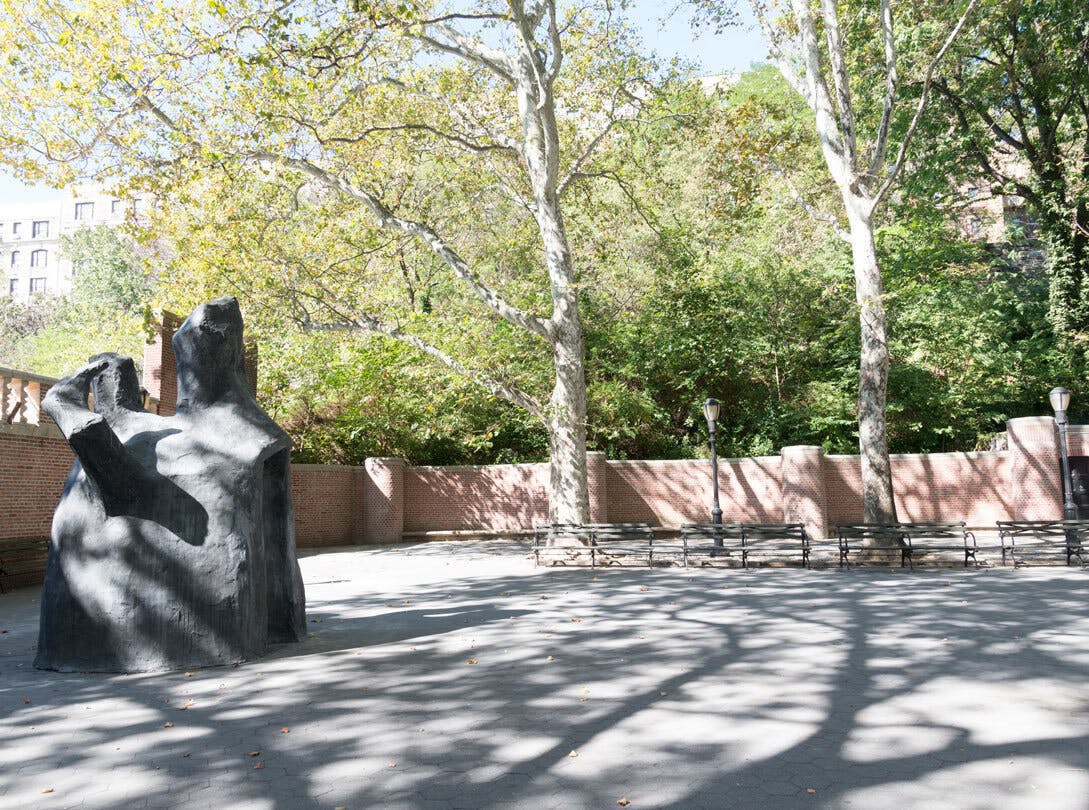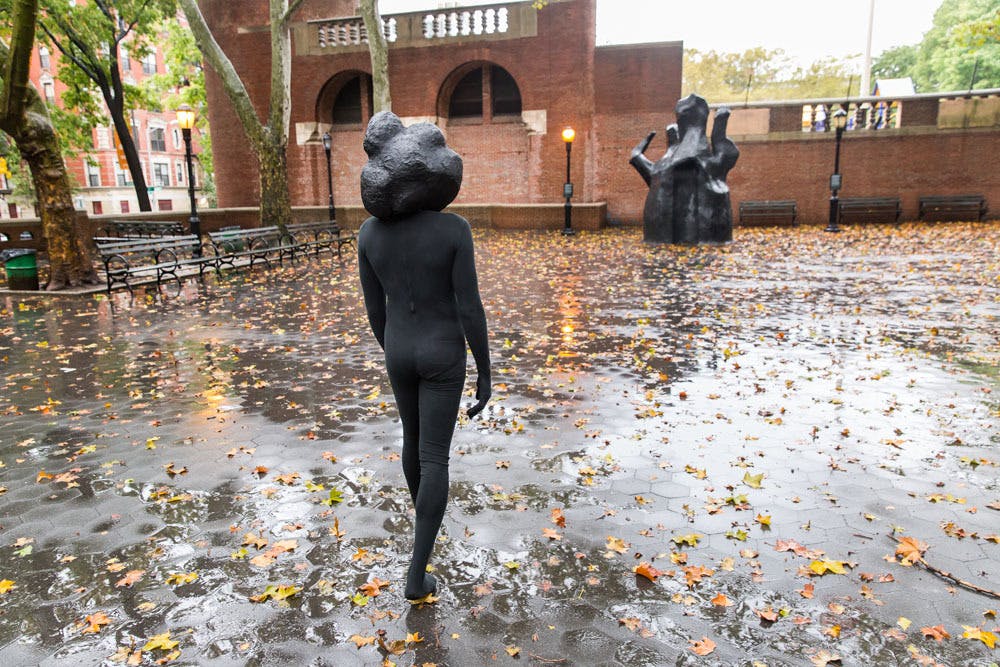inHarlem: Rudy Shepherd
August 25, 2016–July 25, 2017
inHarlem: Rudy Shepherd in Jackie Robinson Park features the sculpture Black Rock Negative Energy Absorber, which was created to dispel feelings of racial prejudice, violence, or disdain by encouraging viewers to be more compassionate.
Created from wood, metal and colored concrete at larger-than-human scale, Black Rock Negative Energy Absorber will be inaugurated with a ceremony featuring the artist and musical collaborators Brian Alfred, Elia Einhorn and Christof Knoche. Both the performance and the sculpture are intended to generate positive energy and dialogue in a rapidly changing neighborhood.
Enter Jackie Robinson Park through the 148th Street and Bradhurst Avenue entrance to find inHarlem: Rudy Shepherd.
inConversation inHarlem
Rudy Shepherd: Public art has been central to my work almost from the beginning and is something I have thought a lot about. I love that public art takes the work and the artists out of the safe, familiar confines of the studio and gallery/museum space and puts them out in the world with regular people. I have always had an interest in communicating with people in a direct way, and working in public seems like the best way to do that. It strips away the barriers some people feel to entering art spaces and brings the work and ideas directly to them in a space where they feel comfortable.
Eric Booker [Assistant Curator and Exhibition Coordinator]: Rudy, this is your fifth Black Rock Negative Energy Absorber. I think it’s great that the work is in Jackie Robinson Park, a place steeped in efforts to bring the community together. How has it felt to have this project in Harlem? Have you observed any remarkable interactions with Black Rock?
RS: The first thing that comes to mind is the overwhelming amount of dialogue I had each day while working on my sculpture in the park, from people walking their dogs each morning, to kids hanging out in the park, to folks that work in the park in different capacities. Everybody wanted to know what I was doing and why. I had people filming and photographing me. I met many local artists, musicians and actors, and I was challenged by each with the fact that I was not working in my quiet studio alone. This was something else—I was in someone else’s space, a communal space used by many different people. It was fun to see how people reacted to my ideas and I was happy to be understood and appreciated. Though one kid did tell me she thought the title of the piece was too long!

EB: Black Rock follows a series of smaller “Healing Devices” you have made, sculptures that make formal and magical analogies to ancient artifacts. Can you talk about the progression of this work?
RS: There are three major strains in my work right now: a series of drawings that chronicle things happening in the world such as the killing of Black men by police officers, the Black Rock Negative Energy Absorber sculptures and Healing Devices that offer up a spiritual solution to these seemingly vast, unsolvable problems, and the Healer performances that articulate my emotional response. They link together to create a gestalt that represents my opinion on the state of the world today. It serves as a historical record of a Black man living in America in 2016 in a way the history books or the Internet never will. It represents not only the things I am seeing, but also how I feel about it and how I would like to see it change. There are plenty of people that will organize marches and write legislation to try to fix these problems, but I believe it is the artist’s job to articulate the problems of the world they live in and bring them alive for people to feel, to open up dialogue and create a space where people feel safe discussing these issues without feeling like they have to be an expert to have a voice. During the construction of my project at Jackie Robinson Park I had many discussions with people young and old, rich and poor, about the state of the world right now, and for me that is what it’s always been about.
Read the full conversation here.
inHarlem: Kevin Beasley, Simone Leigh, Kori Newkirk, Rudy Shepherd is organized by Amanda Hunt, Assistant Curator, in partnership with the NYC Parks along with the Marcus Garvey Park Alliance.
inHarlem: Rudy Shepherd
August 25, 2016–July 25, 2017
inHarlem: Rudy Shepherd in Jackie Robinson Park features the sculpture Black Rock Negative Energy Absorber, which was created to dispel feelings of racial prejudice, violence, or disdain by encouraging viewers to be more compassionate.
Created from wood, metal and colored concrete at larger-than-human scale, Black Rock Negative Energy Absorber will be inaugurated with a ceremony featuring the artist and musical collaborators Brian Alfred, Elia Einhorn and Christof Knoche. Both the performance and the sculpture are intended to generate positive energy and dialogue in a rapidly changing neighborhood.
Enter Jackie Robinson Park through the 148th Street and Bradhurst Avenue entrance to find inHarlem: Rudy Shepherd.
inConversation inHarlem
Rudy Shepherd: Public art has been central to my work almost from the beginning and is something I have thought a lot about. I love that public art takes the work and the artists out of the safe, familiar confines of the studio and gallery/museum space and puts them out in the world with regular people. I have always had an interest in communicating with people in a direct way, and working in public seems like the best way to do that. It strips away the barriers some people feel to entering art spaces and brings the work and ideas directly to them in a space where they feel comfortable.
Eric Booker [Assistant Curator and Exhibition Coordinator]: Rudy, this is your fifth Black Rock Negative Energy Absorber. I think it’s great that the work is in Jackie Robinson Park, a place steeped in efforts to bring the community together. How has it felt to have this project in Harlem? Have you observed any remarkable interactions with Black Rock?
RS: The first thing that comes to mind is the overwhelming amount of dialogue I had each day while working on my sculpture in the park, from people walking their dogs each morning, to kids hanging out in the park, to folks that work in the park in different capacities. Everybody wanted to know what I was doing and why. I had people filming and photographing me. I met many local artists, musicians and actors, and I was challenged by each with the fact that I was not working in my quiet studio alone. This was something else—I was in someone else’s space, a communal space used by many different people. It was fun to see how people reacted to my ideas and I was happy to be understood and appreciated. Though one kid did tell me she thought the title of the piece was too long!

EB: Black Rock follows a series of smaller “Healing Devices” you have made, sculptures that make formal and magical analogies to ancient artifacts. Can you talk about the progression of this work?
RS: There are three major strains in my work right now: a series of drawings that chronicle things happening in the world such as the killing of Black men by police officers, the Black Rock Negative Energy Absorber sculptures and Healing Devices that offer up a spiritual solution to these seemingly vast, unsolvable problems, and the Healer performances that articulate my emotional response. They link together to create a gestalt that represents my opinion on the state of the world today. It serves as a historical record of a Black man living in America in 2016 in a way the history books or the Internet never will. It represents not only the things I am seeing, but also how I feel about it and how I would like to see it change. There are plenty of people that will organize marches and write legislation to try to fix these problems, but I believe it is the artist’s job to articulate the problems of the world they live in and bring them alive for people to feel, to open up dialogue and create a space where people feel safe discussing these issues without feeling like they have to be an expert to have a voice. During the construction of my project at Jackie Robinson Park I had many discussions with people young and old, rich and poor, about the state of the world right now, and for me that is what it’s always been about.
Read the full conversation here.
inHarlem: Kevin Beasley, Simone Leigh, Kori Newkirk, Rudy Shepherd is organized by Amanda Hunt, Assistant Curator, in partnership with the NYC Parks along with the Marcus Garvey Park Alliance.








